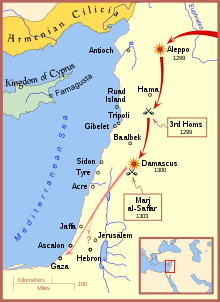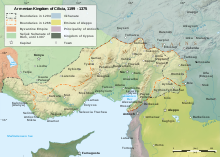Hethum II
| Hethum II | |
|---|---|
Armenian Church |
Hethum II (
First reign
Since 1247, Cilician Armenia itself had been a vassal state of the Mongol Empire, from an agreement made by Hethum II's grandfather,
Hethum II took the throne in his early 20s, when his father Leon II died in 1289. At the time, Cilician Armenia was in a precarious position between major powers, balancing between friendly relations with the Christian Europeans and Byzantine Empire, aggression from the Turkish Sultanate of Rum to the west, a vassal relationship with the aggressive Mongol Empire in the East, and defending itself from attacks from the South, from the Muslim Mamluks out of Egypt. The Crusades had lost European support and were winding down, and Islamic forces were sweeping northwards from Egypt, re-taking land which had earlier been lost to the Crusaders,[2] and pushing back against the Mongol advance.
In 1289,
In 1292,
In 1293, Hethum abdicated in favor of his brother
Second reign
In 1295, Thoros III asked Hethum to resume the throne to help renew the Mongol alliance. Hethum made the long journey to the Mongol capital, and was successfully able to request aid from the Mongols. When he returned to Armenia in 1296, further good news manifested from the Byzantine Empire, with an offer of a marital alliance. Hethum and Thoros placed Armenia under the regency of their brother

Third reign


In 1299, Hethum, recovered at least partially from his blindness, ousted Constantin and once again resumed the crown. Soon thereafter, he again sought assistance from
According to modern traditions, Hethum may have visited
The king of Armenia, back from his raid against the Sultan, went to Jerusalem. He found that all the enemies had been put to flight or exterminated by the Tatars, who had arrived before him. As he entered into Jerusalem, he gathered the Christians, who had been hiding in caverns out of fright. During the 15 days he spent in Jerusalem, he held Christian ceremonies and solemn festivities in the Holy Sepulchre. He was greatly comforted by his visits to the places of the pilgrims. He was still in Jerusalem when he received a certificate from the Khan, bestowing him Jerusalem and the surrounding country. He then returned to join Ghazan in Damas, and spend the winter with him
—Recueil des Historiens des Croisades, Historiens Armeniens I, p.660[8]
Speculation aside, the Mongols retreated northwards a few months later, and the Mamluks reclaimed Palestine with little resistance.
Hethum's gains against the Mamluks were short-lived, as in 1303, the Mamluks counter-attacked from Egypt. The Armenians again joined forces with a sizable number of Mongol troops, 80,000, on a Syrian offensive, but they were defeated at Homs on March 30, 1303, and at the decisive Battle of Shaqhab (Merj-us-Safer), south of Damas, on April 21, 1303.[9] This campaign is considered to be the last major Mongol invasion of Syria.[10] Hethum retreated to Ghazan's court in Moussoul, and then again resigned his crown. His brother Thoros III having been killed in 1298, Hethum passed the crown to Thoros's teenaged son, Leo III. Hethum retired to a monastery, although as Leo was not yet an adult, Hethum retained the office of Regent of Armenia.
Later years

In 1304, the
The Armenian Kingdom of Cilicia's alignment with the Mongol Empire continued, motivated as much by the need for self-protection from the
Notes
- ^ His name has been written Haython, Hayton, Het'um, Hetoum, and Hethoum.
References
Citations
- ^ a b Stewart 2005
- ^ a b c d Kurkjian, pp. 204–205
- ^ a b Claude Mutafian, pp. 73–75
- ^ a b c Demurger, pp. 142–143
- ^ Demurger, p.142 "The Mongols pursued the retreating troops towards the south, but stopped at the level of Gaza"
- RHC Arm. Iversion of the 'Chronicle of the Kingdom', but this passage was in fact inserted into the translation of the chronicle by its editor, Dulaurier, and originates in the (unreliable) work of Nerses Balienc... The "Arab chroniclers" cited are Mufaddal (actually a Copt; the edition of Blochet), al-Maqrizi (Quatremere's translation) and al-Nuwayrf. None of these sources confirm Nerses' story in any way; in fact, as is not made clear in the relevant [Schein] footnote, it is not the text of al-Nuwayrf that is cited, but D.P. Little's discussion of the writer in his Introduction to Mamluk Historiography (Montreal 1970; 24–27), and in that there is absolutely no mention made of any Armenian involvement at all in the events of the year. It is disappointing to find such a cavalier attitude to the Arabic source material." and "Echoes of Hayton's Flor des estoires especially can be found in many works that touch on the kingdom, while this is an extremely tendentious work, designed to be a piece of propaganda." Stewart, p. 15
- ^ Amitai, Mongol Raids into Palestine, 1987
- ^ Historiens Armeniens, p.660
- ^ Demurger, p. 158
- ^ Nicolle, p. 80
Bibliography
- Journal of the Royal Asiatic Society: 236–255.
- Boase, T. S. R. (1978). The Cilician Kingdom of Armenia. Edinburgh: Scottish Academic Press. ISBN 0-7073-0145-9.
- ISBN 978-2-228-90235-9.
- Edwards, Robert W. (1987). The Fortifications of Armenian Cilicia: Dumbarton Oaks Studies 23. Washington, D.C.: Dumbarton Oaks, Trustees for Harvard University. ISBN 0-88402-163-7.
- ISBN 978-1-60444-012-6.
- ISBN 2-271-05105-3.
- ISBN 1-86019-407-9.
- Stewart, Angus (2005). "The Assassination of King Het'um II: The Conversion of The Ilkhans and the Armenians". Journal of the Royal Asiatic Society. 15 (1): 45–61. S2CID 55809524.
- Stewart, Angus Donal (2001). The Armenian Kingdom and the Mamluks: War and diplomacy during the reigns of Het'um II (1289–1307). BRILL. ISBN 90-04-12292-3.
